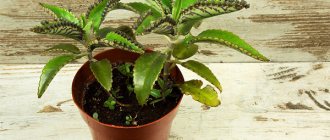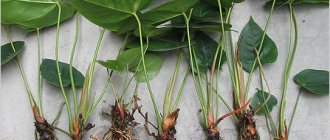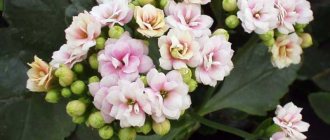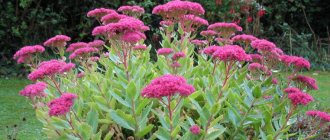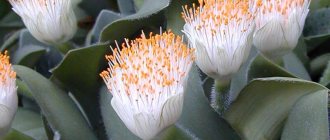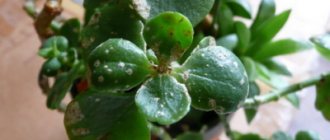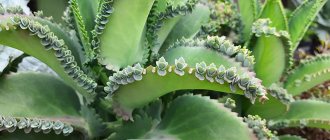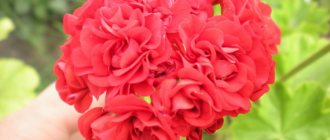Kalanchoe is a medicinal plant, unpretentious and easy to care for. It came to European latitudes from Africa and the Canary Islands. Tends to accumulate water, which contributes to survival in conditions of water deficiency. The stem can reach a height of more than one meter. Reproduces through leaves. It begins to bloom in winter with bright pink flowers. Kalanchoe does not like excess moisture, despite its tropical origin. It is watered so that the soil is moist, but not wet, and so that there is no water left in the pot.
Family doctor, or Kalanchoe doctor, as the flower is often called, is a very useful indoor plant. It does not require special care, and its benefits are more than enough.
What does it look like
What does medicinal Kalanchoe look like?
The most common indoor types:
- Kalanchoe Degremona. Reaches a height of 100 cm. It has triangular leaves, loves the sun;
- Kalanchoe Blossfeld. This species produces flowers. A more decorative variety than described above. The stem length is up to 30 cm. The leaves are round, the flowers are collected in a bunch. The variety prefers a shady place.
Degremona
Reproduction by children: only for Kalanchoe Degremona and Cirrus
Not all types of Kalanchoe can be propagated by children. Such buds form on the edges of the leaves of Kalanchoe Degremona and Cirrus. Many miniature rosettes with ready-made roots are just waiting to meet the ground. The edges of the leaves of Kalanchoe Pinnate are strewn with self-rooting children
Usually in a pot with such plants there are many already rooted children, which, when they fall on the ground, quickly settle down there, taking root and filling the entire pot. But you shouldn’t hope that in a common pot they will turn into independent plants - crowding will interfere with development.
You need to carefully dig up the babies with a spoon or spatula, separate them and plant them in separate pots. In Kalanchoe Degremona, the children also take root independently and actively. You can collect rosettes from the leaves of Kalanchoe.
This is easy to do - they will fall off on their own with a light touch. We collect the babies from the Kalanchoe leaf - they are ready for rooting. All that remains is to plant them for growing in a shallow bowl with soil for succulents. We raise the collected children in a bowl
Healing properties of Kalanchoe
Kalanchoe: home care and main family species
The plant has watery leaves rich in juice. They contain the active substances for which Kalanchoe is so valued. The juice is used for medicinal purposes. In particular, the leaves of the plant contain enzymes and organic acids, as well as flavonoids - special substances that affect the tone of the heart muscle.
Leaves of Kalanchoe Blossfeld
One leaf of the plant contains:
- vitamin C and P;
- tannins;
- flavonoids;
- mineral salts;
- a variety of macro and microelements (copper, manganese, calcium, aluminum, potassium);
- organic acids, etc.;
- polysaccharides;
- silicon;
- iron;
- magnesium.
These microelements promote healing, soothe irritation and inflammation. Thanks to them, burns, wounds and frostbite can be treated.
For your information! In ancient times, the Kalanchoe plant was used as a medicine by many peoples. The famous poet I. Goethe once wrote to his friends: “Starting with one leaf, the Kalanchoe grows many new shoots, so with one true love you can draw new happiness.”
Also, Kalanchoe medicinal purifies the air and disinfects. That is why it is useful to keep it in homes where allergy sufferers live. In addition, it fights the flu virus and other infections.
Kalanchoe is used in gynecology (during childbirth, during reconstructive operations). In dentistry, it helps cure putrefactive bleeding.
In cosmetology, its juice is used to remove dark circles under the eyes, heal minor wounds after operations, and cracks. For problem skin, rubbing a few drops of juice into irritated areas (acne, inflammation, eczema) helps.
Kalanchoe juice is used in many areas. In particular, in:
- surgery, including plastic surgery. From the juice of the plant, there is an acceleration of the regeneration of skin properties, cleansing wounds of pathogenic organisms, as well as a local anesthetic effect;
- ophthalmology. In this area, Kalanchoe is used for diseases of the cornea, keratitis, etc.;
- dentistry. This plant is good for treating stomatitis, gingivitis, periodontal diseases, etc.
Kalanchoe has the following properties:
- antiseptic;
- anti-inflammatory;
- healing;
- bactericidal.
For your information! If the flower is cared for correctly at home, the healing properties of its juice are preserved. If the flower lacked something or the plant was damaged, the properties become less pronounced.
Methods of application in cosmetology
For facial skin
Kalanchoe rejuvenates, moisturizes and tones the skin, relieves irritation and resists the appearance of acne.
The juice is added both to ready-made lotions and creams, and to homemade masks. As a base, use oatmeal diluted with warm water (half a tablespoon of flour, 1 teaspoon of juice and the same amount of olive oil). The pulp from the leaves lightens age spots and improves the condition of problem skin.
Video about using Kalanchoe for facial skin:
For hair beauty
The scalp skin needs care just like the facial skin. Healing juice is rubbed into the skin to get rid of dandruff and strengthen hair follicles , and masks are also made with egg yolk, honey and birch sap (one teaspoon of each component).
For hands and nails
Brittleness and slow growth of the nail plate, the formation of hangnails, dry skin, inflammation and irritation indicate inadequate hand care. Kalanchoe juice will saturate the skin of your hands with vitamins, minerals, moisture and strengthen your nails.
The easiest way to quickly get your hands in order is to add juice to hand cream , but wraps are considered the most effective option. For this purpose, pieces of gauze must be soaked in Kalanchoe juice, wrapped around each finger, put on cotton gloves and held for several hours. The best option is to leave the compress overnight.
Kalanchoe is fraught with many beneficial properties. It is even compared to the miracle of Siberia - the unique ginseng. If the succulent has reached an impressive size, has grown and is disturbing other inhabitants of the windowsill, do not rush to rashly get rid of it: rejuvenate the plant by cuttings, and use the rest to make preparations for preparing medicines and cosmetic products.
What does Kalanchoe treat?
Phalaenopsis orchid: main types and home care options
What Kalanchoe cures is a common question on the Internet. Here is a short list of diseases for which this representative of the flora helps:
- rhinitis;
- colds;
- inflammation of the mucous membrane of the nose and sinuses;
- healing of wounds and burns, the juice has restorative properties;
- bleeding;
- diseases of the digestive system.
Ointment
Kalanchoe does not bloom and stretches upward: what to do?
Kalanchoe stretched up and without flowers
First, determine the possible cause. It's either:
- lack of sunlight, which the plant reaches for
- daylight hours are too long, 12 hours or more
There are also 2 ways out of this situation:
- move the pot of Kalanchoe to the windowsill without any neighbors other than succulents,
- monitor the length of the day for the plant, cover it with opaque polyethylene in the evening until the morning.
Kalanchoe begins to form flower stalks when:
- he has enough strength, that is, watering and fertilizing are normal
- he sees sunlight for no more than 10 hours at a time
How to treat Kalanchoe for adults
Vanilla Orchid: main types and home care options
The Kalanchoe plant is actively used in folk medicine as a cure for many diseases. It can be compared to aloe, but the medicinal properties of Kalanchoe are the best way to combat viral diseases. The disease goes away much faster.
Based on Kalanchoe, the popular medicine Kalankhin was created, which is used in the treatment of gastroenteritis, burns, frostbite and cracked nipples of nursing mothers.
Benefits and medicinal properties
Kalanchoe is a medicinal plant because it has bactericidal, antioxidant, immunostimulating, regenerative, astringent (hemostatic), anti-inflammatory, choleretic, and healing properties.
- In particular, the leaves, stem and juice of this succulent of the Crassulaceae family are used as an internal or external remedy for the treatment of:
- acute respiratory diseases of a viral or bacterial nature (dropping into the nose or wiping its inner walls);
- festering wounds and tissue necrosis;
- burns;
- acne, boils, psoriasis and other skin problems;
- ulcers, including post-traumatic ones, and erosions;
- prostatitis;
- varicose veins;
- bleeding of various origins (external and internal);
- vitamin deficiency;
- some diseases of the organs of vision, in particular, blapharitis, conjunctivitis, glaucoma, destruction of the vitreous body of the eye, etc.;
- stomatitis, periodontal disease, gingivitis and other pathologies associated with gum inflammation.
The health benefits of Kalanchoe are also manifested in the plant’s ability to strengthen the walls of blood vessels, lower blood pressure, and also, thanks to the enzymes included in the succulent, accelerate metabolic processes in the body.
Did you know? It turns out that freshly cut green organs of Kalanchoe contain two times less useful substances than the same fragments that have lain for 7 days in a dark room at a temperature of +3...+6°C.
For medicinal purposes, juice or cut green parts of a succulent are usually used, however, even the very presence of a medicinal plant in the house can have a beneficial effect on the health of the people in it, since biologically active substances with antimicrobial effects are released by the flower during respiration and are concentrated in the air, purifying and disinfecting his.
Video: medicinal properties of Kalanchoe
How to use Kalanchoe
The juice and leaves of the plant are used in different ways.
Kalanchoe for treating colds
To treat a runny nose, a decoction or juice of the leaves is used. Sometimes aloe and onion are added to it. In the latter case, it is very important to maintain the correct proportions.
Note! The therapeutic effect occurs when the nasal mucosa is slightly irritated, which leads to intense sneezing. In this way, a person gets rid of accumulated pathogenic mucus. For this reason, this plant is sometimes called "sneezer".
Before use, it is necessary to check whether a person is allergic to this plant. This is a very important point when using Kalanchoe juice. The plant can unnecessarily irritate the mucous membrane, thereby causing a deterioration in the patient's condition. But, if everything is done correctly and carefully, then a positive result is guaranteed. The mucus will come out of the sinuses, and the person will breathe easier.
Kalanchoe decoction
The uniqueness of the product lies in the fact that Kalanchoe officinalis is suitable for treating people of all ages.
You can get a medicinal decoction from Kalanchoe, for which you will need several leaves. They should be filled with 100 ml of water. Boil this mixture and cool completely. It is very important to use the decoction in small doses.
Plant juice
The easiest way is to simply squeeze the juice out of the leaves by squeezing them between your fingers. If the leaves are dry, they are first crushed and then carefully filtered through a bandage or gauze. You don't need a lot of juice, just 1-2 drops. For children under 2 years old, Kalanchoe juice is diluted with water. Sometimes you can even simply wipe the nasal cavity with a cotton swab dipped in juice.
Juice
Using nasal drops from Kalanchoe and aloe juice is very useful and effective. They are mixed in equal proportions in the amount of 1-2 drops of each plant. This medicine is the most gentle and gives a mild effect.
Important! If there is no allergy to Kalanchoe, the plant juice can be used as a preventative measure. During various epidemics, it is recommended to instill drops into the nose several times a day.
Plant propagation by cuttings
Household Kalanchoe is considered a succulent characterized by rapid growth, so cuttings allow you to get a young plant in the shortest possible time. A bush from a cutting grows on its own within 3-4 weeks.
Cut branches take root well in light substrate or water. You can cut succulents all year round, but the best results are obtained in the spring, when they awaken after a period of dormancy.
Rules for taking cuttings
- Strong and succulent shoots are suitable for propagation using this method. You can use the twigs left over when forming the bush.
- The minimum cutting length is 5 cm, the maximum is 10-12 cm.
- It is desirable that the rooted shoot have at least 3 short internodes.
- In order for the Kalanchoe to retain its varietal characteristics and for the bush to grow aesthetically pleasing and neat, it is better to take branches from the top of the plant.
- Remove leaves from the bottom, leaving only 2-3 pairs on the branch.
Make cuts with a clean, sharp tool, and sprinkle the wounds on the plant with crushed coal.
Important point! Immediately after harvesting, it is advisable to dry the cuttings - leave them in the open air for a period of 6 hours to 1-2 days. This will protect the stems from rotting.
It is also known that in Kalanchoe placed in extreme conditions, regeneration processes start faster, which contributes to faster rooting.
If you leave the cutting in the air for a longer time, roots may appear without water; the plant will try to reach the ground with them.
There is no consensus among gardeners about the drying time - it all depends on the area of the cut.
What to do next? Kalanchoe cuttings produce roots both in water and in soil. In the first case, it is enough to put the air-dried shoots in a jar. Pour a little water - a level of 2-3 cm is enough, since with a larger volume there will not be enough air for the development of roots.
The cut of the cutting should not reach the bottom of the jar, the temperature is +23...24º C. After the roots have formed, plant the plant in a soil mixture for succulents.
To plant a cutting in a pot, take either clean, damp sand, or prepare a light substrate with good aeration. In the first case, after complete rooting, the Kalanchoe is transplanted to a permanent place; in the second, this is not necessary. The composition of the substrate may be different:
- ready-made store-bought mixture intended for succulent plants;
- universal soil for indoor plants and the same volume of sand;
- a mixture of turf soil, leaf soil, peat, humus, coarse sand in the proportion: 1: 1: 1: 1: 2.
The root system of Kalanchoe is small, so a pot with a diameter of 5-10 cm is enough for cuttings.
Please note: succulents do not tolerate stagnant waterlogging. Therefore, the main condition for proper planting is the presence of holes in the bottom and a drainage layer consisting of pebbles, expanded clay, and sand.
Plant the cuttings in the substrate to a depth of 1-1.5 cm - so that the soil reaches the lower leaves. Place the pot on a windowsill with intense but diffuse lighting, making sure the soil does not dry out. There is no need to cover the cuttings on top with film or a jar - there is enough moisture in parts of the succulents for rooting.
Contraindications to the use of Kalanchoe
People with diseases of the liver, kidneys and joints should be more careful when treating Kalanchoe. There may be allergic reactions in nursing and pregnant women (during pregnancy it is generally advisable to refrain from treatment with this method).
Before use, it is better to consult a doctor, especially for people prone to allergies. Also, you should not use the plant juice for low blood pressure, tumors, or hepatitis.
Note! In its pure form, Kalanchoe is not suitable for children, because the child may have a burn to the nasal mucosa. It is best to test for allergic reactions before use to avoid unwanted effects.
All medications, even if they are natural, should be used after consultation with a doctor; this is a prerequisite for treatment.
About contraindications of alcohol tincture
Most folk recipes include only natural ingredients, and therefore have much fewer contraindications and side effects. Despite the obvious benefits, Kalanchoe tincture still has contraindications; it is not recommended for use in the following cases:
- during pregnancy and breastfeeding;
- if there is individual intolerance and hypersensitivity to substances contained in the plant;
- for oncological diseases;
- for serious liver diseases;
- for a rare intestinal disease of infectious origin - Whipple's disease.
It is not recommended to give alcohol solution to children to drink; as for external use, it is important to take precautions and, if necessary, dilute the composition with water to reduce the concentration of alcohol and active substances. Another caveat is that people suffering from alcohol addiction should not take medications containing alcohol.
Another caveat is that people suffering from alcohol addiction should not take medications containing alcohol.
Traditional medicine recipes
The leaves located as close as possible to the stem of the plant are best suited for preparing medicinal tinctures.
- Tincture. This is the first folk remedy. To prepare, you need to finely chop the leaves, pour vodka or alcohol into them, and leave them in a dark place for two weeks. Then the finished tincture should be stored in the refrigerator. Use for varicose veins, brittle nails, inflammation and wounds. You can rinse your mouth.
Drops
- Ointment. Mix fresh juice with Vaseline or fat. Mix thoroughly and keep in a water bath for half an hour. Store the resulting mixture in the refrigerator. It is a good remedy for treating wounds, inflammation, reducing swelling (such as varicose veins or dark circles under the eyes), and when used for cosmetic purposes. Useful for skin diseases, does not cause itching or burning.
- Fresh Juice. Used for ENT diseases; in the early stages, use a few drops 5 times a day. In this way, you can still treat warts and wounds by fixing the tampon on the problem area with a bandage.
For ear pain
The plant helps with many ailments. The following recipe will help people suffering from ear pain. The product will relieve severe pain. It is even used for moderate otitis media. You will need 2 tbsp. spoons of Kalanchoe juice and 200 g of 40% alcohol. Infuse for 10 days in the room. For treatment, 1-2 drops of tincture are instilled into the ear.
Using Kalanchoe for cosmetic purposes
In cosmetology, the houseplant Kalanchoe has healing properties and is primarily used to care for problem skin. At home, you can prepare a mask or balm from the juice of the plant.
Mask
First, you need to remove the skin from the leaves and lightly rub your face so that the medicinal juice is absorbed into it. After cleansing, apply nourishing cream. The toning effect will be noticeable after the first sessions.
This method can also be used to combat freckles or spots on the skin.
Important! It is worth remembering that the juice should not be applied to the area around the eyes, and it is better to cleanse before bed.
If we talk about Kalanchoe, there are a great many traditional medicine recipes.
- The juice treats stomach ulcers. To do this, you need to take 1 teaspoon three times a day for a month.
- If you have the flu, lubricate the nasal mucosa with juice three times a day.
- For ear pain, instill the juice 3-4 times a day, 1-2 drops.
- If eyelids become irritated, wipe 3-4 times a day.
- Rinse the mouth for various inflammations and gum diseases.
- For mastitis, apply compresses 2-3 times a day.
- The juice is used for kidney inflammation, tuberculosis, psoriasis, warts and even mental and physical fatigue.
Do not forget that the mechanism of action of herbal preparations has not yet been fully studied.
Note! If Kalanchoe tinctures are made at home, you need to store them in dark places at low temperatures. This way, the concentration of elements that give a therapeutic effect will be maximum, and every beneficial property of the juice will be preserved.
When is juice needed?
It is allowed to use fresh raw materials to make juice. This remedy can be safely used to treat a runny nose and gargle. But it is better to use, if time permits, aged raw materials.
Preparation
- The Kalanchoe leaf is removed from the refrigerator and washed with water.
- Plant materials are wiped with a napkin.
- The leaf is crushed and the juice is squeezed out through cheesecloth.
The drink can be stored in a glass container for one week. The container with the medicinal liquid is stored only in the refrigerator.
How to use
Both local and internal use of Kalanchoe juice is acceptable. But in the latter case, the doctor's permission is required. Especially if the therapy is intended for children.
- Runny nose. For rhinitis, instillation of Kalanchoe juice into the nose helps. To do this, three to four drops are dripped into each nasal passage. After a while, strong sneezing will appear, after which the nose will effectively clear. Repeat the procedure every two hours. But this therapy is acceptable for adults. Treatment of Kalanchoe runny nose in children requires a reduction in dosage. Preschoolers receive one drop at a time, and schoolchildren can increase the dose to two. The event is also repeated every two hours.
- Sinusitis. An effective remedy helps to cope not only with rhinitis, but will also bring significant benefits in such complex pathologies as sinusitis. The nose is instilled with Kalanchoe juice in the same way as for a regular runny nose. The procedure is repeated for three to four days. This enhanced therapy will ensure cleansing of the maxillary sinuses.
- Adenoids. Children under the age of ten are often tormented by adenoids. Daily instillation of medicinal juice into the nose will help significantly alleviate the condition of a small patient. For adenoids, the dosage of the medicine is three drops. Drop into the nose three times a day. Improvements are noticed immediately. The cavities are cleansed, breathing becomes easier, and pain is reduced.
- Tuberculosis. Kalanchoe therapy is considered only as an additional direction. A teaspoon of juice is diluted in a third of a glass of water. To reduce the severity of symptoms caused by tuberculosis, take this medicine 30 minutes before meals twice a day.
- Erosion of the uterus. The juice is in demand in gynecology. But before use, it is diluted in equal proportions with water. The natural product is too concentrated and can leave a burn on the mucous membrane. To heal erosion, it is recommended to soak a tampon in diluted juice and leave it overnight. The production continues for two weeks.
Quite simple methods can cope with many diseases. But sometimes Kalanchoe juice has to be combined with other ingredients. For example, to cure a cough, add 100 g of honey, butter, interior fat and 50 g of cocoa to the plant component (two tablespoons). Take a teaspoon with milk. Three doses of the medicine are enough to forget about the cough.
Kalanchoe: home care
To grow a miracle flower at home, it is important to take into account some rules.
Basic lighting requirements
Kalanchoe needs good lighting. From morning until two o'clock in the afternoon, you need to maintain bright light (for example, keep a flower on the windowsill). After lunch, there is no need for such intense lighting, so you can move the flower to a darker place. In winter, Kalanchoe needs more light, so the plant is best placed on a windowsill on the south side of the house.
Temperature
Kalanchoe itself feels best at 17-19 °C, but even if the temperature in the room drops to 5-6 °C, this will not affect the condition of the flower.
Important! What you definitely need to protect it from is heat. At high temperatures, it tries to absorb more moisture, which can cause various diseases or rotting.
How to water an indoor flower
As already mentioned, excess moisture is detrimental to the flower. It's best to just water it with cool water. When watering, you need to avoid getting water on the surface of the stems and leaves, this leads to their rotting. Water sparingly to keep the soil moist but not waterlogged.
The watering procedure should be repeated on average once a week. Use cool, settled water.
Due to the fact that the plant accumulates a lot of moisture in its leaves, it can easily tolerate short periods of drought. At the same time, Kalanchoe categorically does not tolerate high humidity. In winter and autumn, watering is carried out half as often.
Important! Dusty leaves should simply be wiped with a slightly damp cloth. It is also necessary to remove wilted inflorescences and diseased leaves that begin to curl, turn yellow and dry out, otherwise the flowers may begin to fall off.
Kalanchoe can be propagated. To do this, in May or June, the tops of the shoots are transplanted into a mixture of sand and clay. Young shoots that appear after removing old inflorescences are well suited for seedlings.
Kalanchoe medicinal flower is a very useful plant that will help with many diseases and their prevention. In addition, some of its species produce beautiful flowering and will be a good decoration for the home. Medicinal Kalanchoe, care for which at home is easy and simple, unpretentious. In response to care, the flower will purify the air in the room, and its juice will be rich in various microelements. What does Kalanchoe treat? Almost everything, this is its uniqueness.
Diseases and pests of indoor Kalanchoe
With proper care, Kalanchoe rarely gets sick. But from time to time, the succulent can be affected by gray mold or powdery mildew.
Powdery mildew
A dangerous fungal disease occurs from excessive humidity. Kalanchoe affected by powdery mildew begins to shed its leaves and then dies completely. At the first suspicion of a disease, the gardener should begin to treat the tree of life. Powdery mildew is an infectious disease and can quickly spread to other green plants.
The sick plant must be isolated from the rest of the household. The disease is fought with fungicides Aktarofit, Fitoverm, etc.
Gray mold
It is impossible not to notice this fungus - it spreads to all parts of the plant. Brown watery spots are visible on the stems, and grayish dust accumulates in small piles on the leaves.
Gray mold affects plants that have been watered incorrectly or irregularly. That is why it is important to prevent constant stagnation of moisture in the soil. Fallen leaves must be removed from the pot to prevent the development of fungus. The soil is partially replaced, the Kalanchoe is treated with a fungicide and placed closer to the light.
Actellik and Commander are suitable medications. They treat the plant twice with an interval of 2 weeks. Solutions are prepared according to instructions.
In addition, possible troubles that you may encounter during breeding:
- roots rot - may be a consequence of a fungal infection, the result of excess moisture during watering;
- leaves growing from below turn yellow and fall off - this is probably the result of excess sunlight or too hot air, especially if the plant is located near a radiator;
- leaves wither, stems turn black - lack of sufficient light or its excess in combination with excessive watering;
- the stems and axils of the leaves turn black - the cause is most often excess moisture and drafts;
- Kalanchoe grows slowly - fertilizing is recommended for the plant;
- the stems stretch out in length, and the lower leaves fly off - perhaps the plant is experiencing a lack of sunlight: in the summer you need to keep the flower pot on the east or west side, and in winter you should choose the south;
- leaves fall - lack of nutrients or cold room;
- after the flowering period, Kalanchoe does not grow or sheds its leaves - a sign that the flower does not have enough nutrition: this problem can be solved by replanting or feeding with special mixtures;
- does not bloom, but the leaves are large - there was an excess of fertilizers, you need to stop feeding the plant and wait;
- spots of brown or black color suddenly appear on the leaves of Kalanchoe - the plant begins to rot due to high humidity combined with low ambient temperatures;
- There is a white coating on the leaves - powdery mildew. It is recommended to treat with a fungicide when such plaque appears; it must be repeated at least three times. 10 days should pass between treatments with the solution.
Among the pests of indoor plants, Kalanchoe is most often affected by mealybugs, common spider mites, and scale insects.
